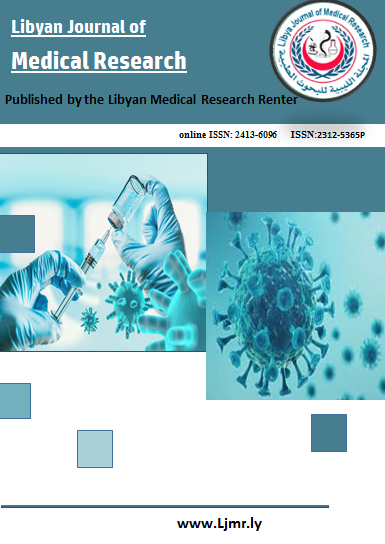Rehabilitation of Partially Edentulous Patients Using a Flexible Removable Partial Denture - A Case Report
DOI:
https://doi.org/10.54361/LJMR.19.1.15Keywords:
Flexible Removable Partial Denture, Partial Edentulism, Dental Prosthetics, , Valplast, Flexiplast, Case ReportAbstract
Partially edentulous patients often face functional and aesthetic challenges that significantly impact their quality of life. This case report presents the aesthetic and functional rehabilitation of patients with partial tooth loss using flexible removable partial dentures. The main treatment options for partial tooth loss include fixed partial dentures (FPDs) either conventional or implant-supported and removable partial dentures (RPDs). When fixed options are not feasible, RPDs may be the only alternative. However, clasps in the aesthetic zone of traditional RPDs can be visually unappealing. Flexible partial dentures, among various materials for removable dentures, provide enhanced aesthetics and are particularly suited for patients prioritizing appearance.
Downloads
References
Thakral G, Aeran H, Yadav B, Thakral R. Flexible Partial Dentures – A hope for the Challenged Mouth. People’s Journal of Scientific Research, 2012;5(2):55-9.
Singh K, Aeran H, Kumar N, Gupta N. Flexible Thermoplastic Denture Base Materials for Aesthetical Removable Partial Denture Framework. Journal of Clinical and Diagnostic Research, 2013; 7(10): 2372-3.
Jain AR. Flexible Denture for Partially Edentulous Arches - Case Reports. International Journal of Recent Advances in Multidisciplinary Research 2015; 2(1):182- 6.
Mijoska, A. (March, 2019). "FLEXIBLE POLYMER DENTURES - CONTEMPORARY SOLUTIONS FOR SUPERIOR ESTHETIC AND COMFORТVol.30.4." KNOWLEDGE – International Journal Vol.30.4.
Yunus N, Rashid AA, Azmi LL, Abu Hassan MI. Some flexural. Properties of a nylon denture base polymer. J Oral Rehabil. 2005; 32:65-71.
Parvizi A, Lindquist T, Schneider R, Williamson D, Boyer D, Dawson DV. Comparison of the dimensional accuracy of injection-molded denture base materials to that of conventional pressure-pack acrylic resin. J Prosthodont Off J Am CollProsthodont 2004 Jun;13(2):83–9.
Phoenix RD, Mansueto MA, Ackerman NA, Jones RE. Evaluation of mechanical and thermal properties of commonly used denture base resins. J Prosthodont Off J Am CollProsthodont 2004 Mar;13(1):17–27.
Downloads
Published
Issue
Section
License
Copyright (c) 2025 Aihab Albaden, Zohir Alaosta , Anas Sherif (Author)

This work is licensed under a Creative Commons Attribution-NonCommercial-NoDerivatives 4.0 International License.
Open Access Policy
Libyan journal of medical Research (LJMR).is an open journal, therefore there are no fees required for downloading any publication from the journal website by authors, readers, and institution.
The journal applies the license of CC BY (a Creative Commons Attribution 4.0 International license). This license allows authors to keep ownership f the copyright of their papers. But this license permits any user to download , print out, extract, reuse, archive, and distribute the article, so long as appropriate credit is given to the authors and the source of the work.
The license ensures that the article will be available as widely as possible and that the article can be included in any scientific archive.
Editorial Policy
The publication of an article in a peer reviewed journal is an essential model for Libyan journal of medical Research (LJMR). It is necessary to agree upon standards of expected ethical behavior for all parties involved in the act of publishing: the author, the journal editorial, the peer reviewer and the publisher.
Any manuscript or substantial parts of it, submitted to the journal must not be under consideration by any other journal. In general, the manuscript should not have already been published in any journal or other citable form, although it may have been deposited on a preprint server. Authors are required to ensure that no material submitted as part of a manuscript infringes existing copyrights, or the rights of a third party.
Authorship Policy
The manuscript authorship should be limited to those who have made a significant contribution and intellectual input to the research submitted to the journal, including design, performance, interpretation of the reported study, and writing the manuscript. All those who have made significant contributions should be listed as co-authors.
Others who have participated in certain substantive aspects of the manuscript but without intellectual input should only be recognized in the acknowledgements section of the manuscript. Also, one of the authors should be selected as the corresponding author to communicate with the journal and approve the final version of the manuscript for publication in the LJMR.
Peer-review Policy
- All the manuscripts submitted to LJMR will be subjected to the double-blinded peer-review process;
- The manuscript will be reviewed by two suitable experts in the respective subject area.
- Reports of all the reviewers will be considered while deciding on acceptance/revision or rejection of a manuscript.
- Editor-In-Chief will make the final decision, based on the reviewer’s comments.
- Editor-In-Chief can ask one or more advisory board members for their suggestions upon a manuscript, before making the final decision.
- Associate editor and review editors provide administrative support to maintain the integrity of the peer-review process.
- In case, authors challenge the editor’s negative decision with suitable arguments, the manuscript can be sent to one more reviewer and the final decision will be made based upon his recommendations.













